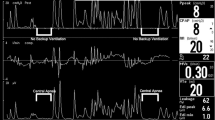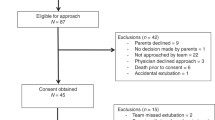Abstract
Mechanical ventilation is associated with significant short- and long-term morbidity in small preterm infants. Continuous positive airway pressure applied through nasal prongs is an effective, less-invasive method to improve gas exchange and reduce apnea in these infants. A large number of studies have evaluated the possibility of reducing the need or duration of mechanical ventilation by early use of nasal continuous positive airway pressure shortly after birth and by applying it after extubation. Although results of these trials have not been consistent, most of the evidence suggests that nasal continuous positive airway pressure is a viable alternative to mechanical ventilation in many preterm infants and that its use after extubation contributes to maintain better lung function and reduces apnea. Despite this, there is no evidence that these beneficial short-term effects translate into lower rates of long-term morbidity such as bronchopulmonary dysplasia and neurologic sequelae or mortality rates.
This is a preview of subscription content, access via your institution
Access options
Subscribe to this journal
Receive 12 print issues and online access
$259.00 per year
only $21.58 per issue
Buy this article
- Purchase on Springer Link
- Instant access to full article PDF
Prices may be subject to local taxes which are calculated during checkout
Similar content being viewed by others
References
Bancalari E, Claure N, Sosenko IRS . Bronchopulmonary dysplasia. Changes in pathogenesis, epidemiology and definition. Semin Neonatol 2003; 8: 63–71.
Ho JJ, Subramaniam P, Henderson-Smart DJ, Davis PG . Continuous distending pressure for respiratory distress syndrome in preterm infants (Review) Cochrane Collaboration Syst Rev 4, 2004.
Saunders RA, Milner AD, Hopkin IE . The effects of continuous positive airway pressure on lung mechanics and lung volumes in the neonate. Biol Neonate 1976; 29: 178–186.
Krouskop RW, Brown EG, Sweet AY . The early use of continuous positive airway pressure in the treatment of idiopathic respiratory distress syndrome. J Pediatr 1975; 87: 263–267.
Richardson CP, Jung AL . Effects of continuous positive airway pressure on pulmonary function and blood gases of infants with respiratory distress syndrome. Pediatr Res 1978; 12: 771–774.
Gregory GA, Kitterman JA, Phibbs RH, Tooley WH, Hamilton WK . Treatment of the idiopathic respiratory distress syndrome with continuous positive airway pressure. N Engl J Med 1971; 284: 1333–1340.
Rhodes PG, Hall RT . Continuous positive airway pressure delivered by facemask in infants with the idiopathic respiratory distress syndrome: a controlled study. Pediatrics 1973; 52: 1–5.
Mockrin LD, Bancalari EH . Early versus delayed initiation of continuous negative pressure in infants with hyaline membrane disease. J Pediatr 1975; 87: 596–600.
Hegyi T, Hiatt IM . The effect of continuous positive airway pressure on the course of respiratory distress syndrome: the benefits on early initiation. Crit Care Med 1981; 9: 38–41.
Gittermann MK, Fusch C, Gittermann AR, Regazzoni BM, Moessinger AC . Early nasal continuous positive airway pressure treatment reduces the need for intubation in very low birth weight infants. Eur J Pediatr 1997; 156: 384–388.
Jonsson B, Katz-Salamon M, Faxelius G, Broberger U, Lagercrantz H . Neonatal care of very-low-birthweight infants in special-care units and neonatal intensive-care units in Stockholm, early nasal continuous positive airway pressure versus mechanical ventilation: gains and losses. Acta Pediatr Suppl 1997; 419: 4–10.
Lindner W, Voßbeck S, Hummler H, Pohlandt F . Delivery room management of extremely low birth weight infants: spontaneous breathing or intubation? Pediatrics 1999; 103: 961–967.
Poets CF, Sens B . Changes in intubation rates and outcome of very low birth weight infants: a population based study. Pediatrics 1996; 98: 24–27.
De Klerk AM, De Klerk RK . Nasal continuous positive airway pressure and outcomes of preterm infants. J Paediatr Child Health 2001; 37: 161–167.
Kamper J, Ringsted C . Early treatment of idiopathic respiratory distress syndrome using binasal continuous positive airway pressure. Acta Paediatr Scand 1990; 79: 581–586.
Avery ME, Tooley WH, Keller JB, Hurd SS, Bryan MH, Cotton RB et al. Is chronic lung disease in low birth weight infants preventable? A survey of eight centers. Pediatrics 1987; 79: 26–30.
Van Marter LJ, Allred EN, Pagano M . Do clinical markers of barotrauma and oxygen toxicity explain inter-hospital variation in rates of chronic lung disease? Pediatrics 2000; 105: 1194–1201.
Narendran V, Donovan EF, Hoath SB, Akinbi HT, Steichen JJ, Jobe AH . Early bubble CPAP and outcomes in ELBW preterm infants. J Perinatol 2003; 23: 195–199.
Aly HZ . Nasal prongs continuous positive airway pressure: a simple yet powerful tool. Pediatrics 2001; 1083: 759–761.
Subramaniam P, Henderson-Smart DJ, Davis PG . Prophylactic nasal continuous positive airways pressure for preventing morbidity and mortality in very preterm infants (Review) Cochrane Collaboration Syst Rev 2, 2000.
Han VKM, Beverley DW, Clarson C, Sumabat WO, Shaheed WA, Brabyn DG et al. Randomized controlled trial of very early continuous distending pressure in the management of preterm infants. Early Hum Dev 1987; 15: 21–32.
Finer NN, Carlo WA, Duara S, Fanaroff AA, Donovan EF, Wright LL et al. Delivery room continuous positive airway pressure/positive end expiratory pressure in extremely low birth weight infants: a feasibility trial. Pediatrics 2004; 114: 651–657.
Ammari A, Suri M, Milisavljevic V, Bateman D, Sanocka U, Ruzal-Shapiro C et al. Variables associated with the early failure of nasal CPAP in very low birth weight infants. J Pediatr 2005; 147(3): 341–347.
Sandri F, Ancora G, Lanzoni A, Tagliabua P, Colnaghi M, Ventura ML et al. Prophylactic nasal continuous positive airway pressure in newborns of 28–31 weeks gestation: multicentre randomised controlled clinical trial. Arch Dis Child Fetal Neonatal Ed 2004; 89: F394–F398.
Verder H, Robertson B, Greisen G, Ebbesen F, Albertsen P, Lundstrom K et al. Surfactant therapy and nasal continuous positive airway pressure for newborns with respiratory distress syndrome. N Engl J Med 1994; 331: 1051–1055.
Verder H, Albertsen P, Ebbesen F, Greisen G, Robertson B, Bertelsen A et al. Nasal continuous positive airway pressure and early surfactant therapy for respiratory distress syndrome in newborns of less than 30 weeks' gestation. Pediatrics 1999; 103: E24.
Thomson M . Early continuous positive airway pressure (nCPAP) with prophylactic surfactant for neonates at risk of RDS: IFDAS multicentre randomized trial. Pediatr Res 2002; 51: 379A.
Tooley J, Dyke M . Randomized study of nasal continuous positive airway pressure in the preterm infant with respiratory distress syndrome. Acta Paediatr 2003; 92: 1170–1174.
Dani C, Bertini G, Pezzati M, Cecchi A, Caviglioli C, Rubaltelli F . Early extubation and nasal continuous positive airway pressure after surfactant treatment for respiratory distress syndrome among preterm infants <30 weeks gestation. Pediatrics 2005; 113: e560.
Reininger A, Khalak R, Kending J, Ryan R, Stevens T, Reubens L et al. Surfactant administration by transient intubation in infants 29–35 weeks' gestation with respiratory distress syndrome decreases the likelihood of later mechanical ventilation: a randomized controlled trial. J Perinatol 2005; 25(11): 703–708.
Engelke SC, Roloff DW, Kuhns LR . Postextubation nasal continuous positive airway pressure. Am J Dis Child 1982; 136: 359–361.
Andréasson B, Lindroth M, Svenningsen NW, Jonson B . Effects on respiration of CPAP immediately after extubation in the very preterm infant. Pediatr Pulmonol 1988; 4: 213–218.
Higgins RD, Richter SE, Davis JM . Nasal continuous positive airway pressure facilitates extubation of very low birth weight neonates. Pediatrics 1991; 88: 999–1003.
Davis PG, Henderson-Smart DJ . Post-extubation prophylactic nasal continuous positive airway pressure in preterm infants: systematic review and meta-analysis. J Paediatr Child Health 1999; 35: 367–371.
Peake M, Dillon P, Shaw NJ . Randomized trial of continuous positive airway pressure to prevent reventilation in preterm infants. Pediatr Pulmonol 2005; 39: 247–250.
Lin CH, Wang ST, Lin YJ, Yeh TF . Efficacy of nasal intermitent positive-pressure ventilation in treating apnea of prematurity. Pediatr Pulmonol 1998; 26: 349–353.
Martin RJ, Nearman HS, Katona PG, Klaus MH . The effect of a low continuous positive airway pressure on the reflex control of respiration in the preterm infant. J Pediatr 1977; 90: 976–981.
Miller MJ, Carlo WA, Martin RJ . Continuous positive airway pressure selectively reduces obstructive apnea in preterm infants. J Pediatr 1985; 106: 91–94.
Locke R, Greenspan JS, Shaffer TH, Rubenstein SD, Wolfson MR . Effect of nasal CPAP on thoracoabdominal motion in neonates with respiratory insufficiency. Pediatr Pulmonol 1991; 11: 259–264.
De Paoli AG, Morely CJ, Davis PG, Lau R, Hingeley E . In vitro comparison of nasal continuous positive airway pressure devices for neonates. Arch Dis Chil Fetal Neonatal Ed 2002; 86: F42–F45.
Morley CJ, Lau R, De Paoli A, Davis PG . Nasal continuous positive airway pressure: does bubbling improve gas exchange? Arch Dis Child Fetal Neonatal Ed 2005; 90(4): F343.
Lee KS, Dunn MS, Fenwick M, Shenman AT . A comparison of underwater bubble continuous positive airway pressure with ventilator-derived continuous positive airway pressure in premature neonates ready for extubation. Biol Neonate 1998; 73: 69–75.
Stefanescu BM, Murphy WP, Hansell BJ, Fuloria M, Morgan TM, Aschner JL . A randomized, controlled trial comparing two different continuous positive airway pressure systems for the successful extubation of extremely low birth weight infants. Pediatrics 2003; 112: 1031–1038.
De Paoli AG, Davis PG, Lemyre B . Nasal continuous positive airway pressure versus intermittent positive pressure ventilation for preterm neonates: a systematic review and meta-analysis. Acta Paediatr 2003; 92: 70–75.
Santin R, Brodsky N, Bhandari V . A prospective observational pilot study of synchronized nasal intermittent positive pressure ventilation (SNIPPV) as a primary mode of ventilation in infants ⩾28 weeks with respiratory distress syndrome (RDS). J Perinatol 2004; 24: 487–493.
Author information
Authors and Affiliations
Corresponding author
Rights and permissions
About this article
Cite this article
Bancalari, E., del Moral, T. Continuous positive airway pressure: early, late, or stay with synchronized intermittent mandatory ventilation?. J Perinatol 26 (Suppl 1), S33–S37 (2006). https://doi.org/10.1038/sj.jp.7211471
Published:
Issue Date:
DOI: https://doi.org/10.1038/sj.jp.7211471
Keywords
This article is cited by
-
Clinical practice
European Journal of Pediatrics (2010)
-
A randomized controlled trial of synchronized nasal intermittent positive pressure ventilation in RDS
Journal of Perinatology (2007)



